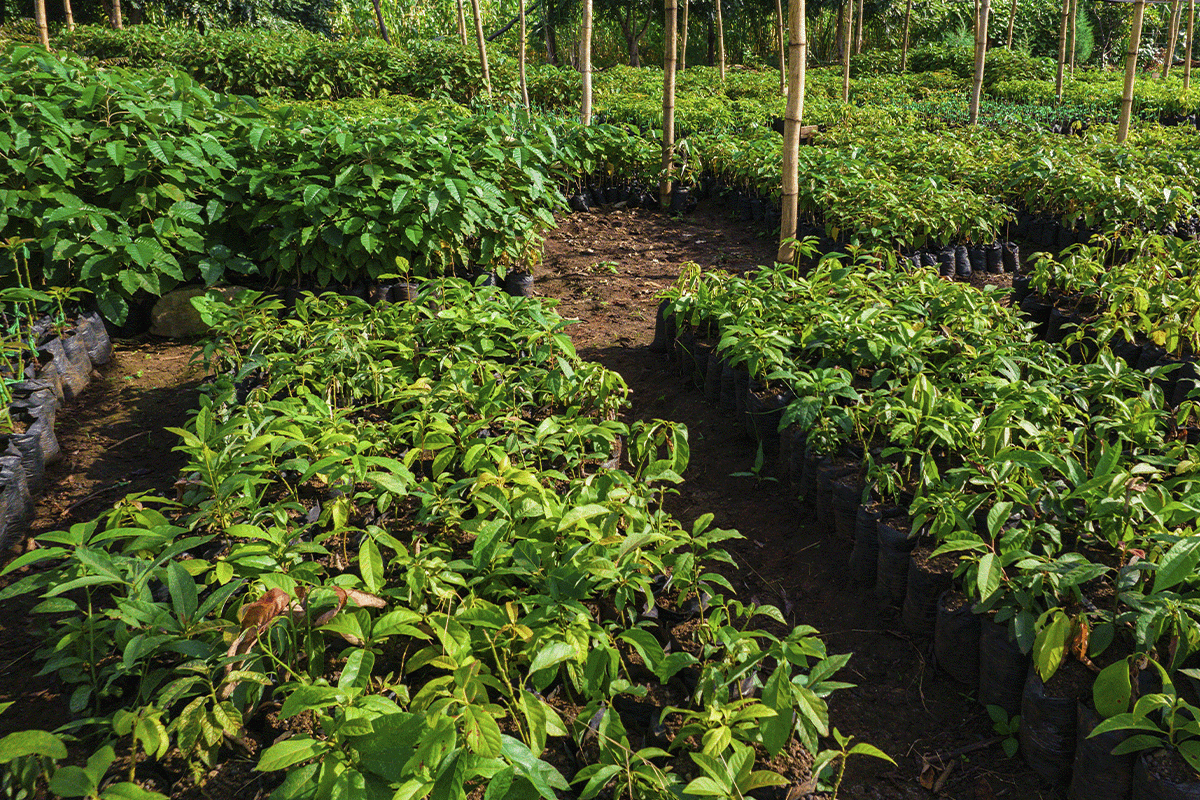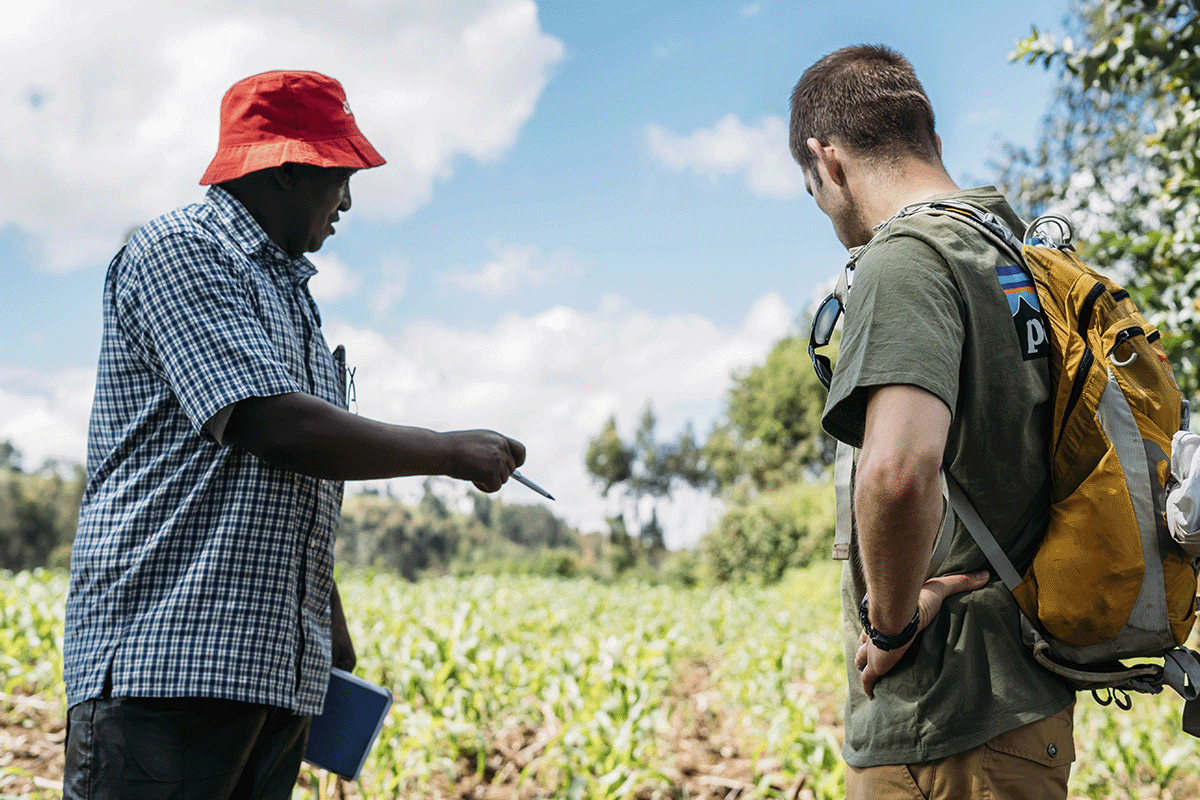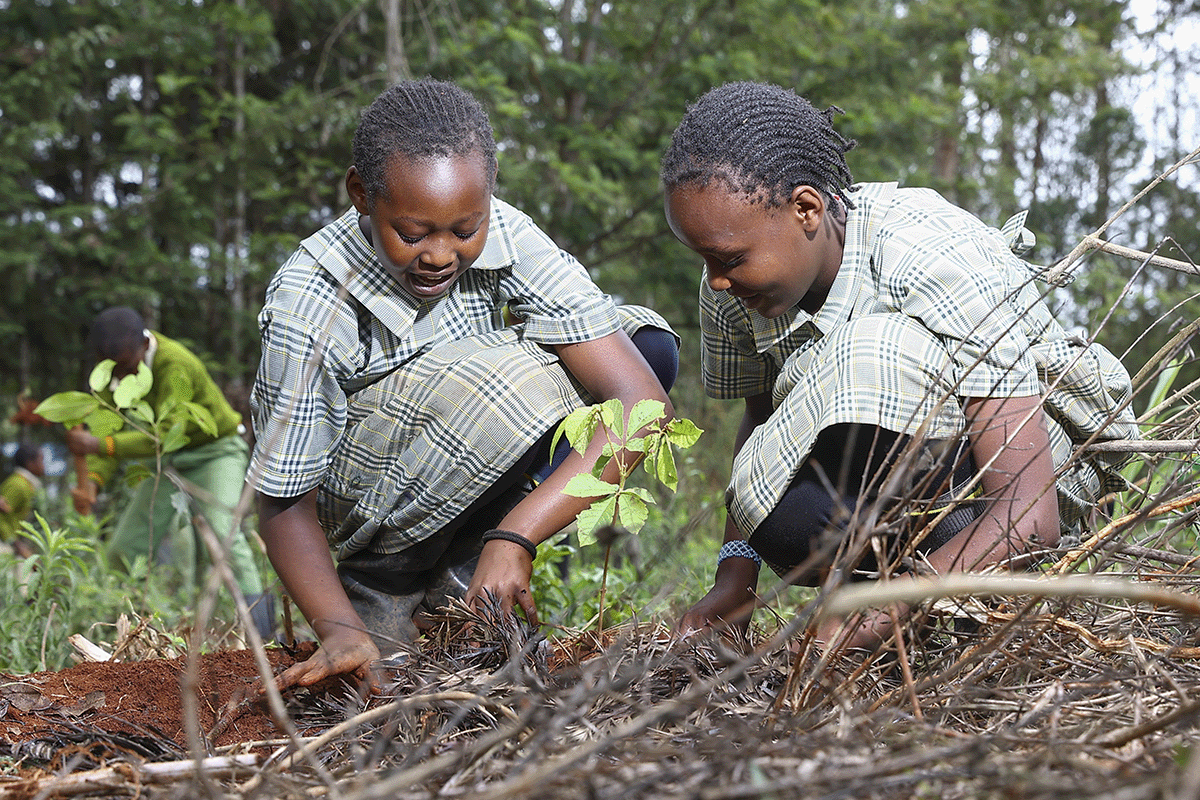Carbon credits are a vital tool in the global effort to reduce carbon emissions. They represent a unit of measurement that quantifies the reduction of greenhouse gas emissions. One carbon credit is equivalent to 1 tonne of carbon dioxide equivalent (CO2e) emissions. These credits can be bought, sold, and traded in the carbon market, incentivising individuals, businesses, and governments to take responsibility for their carbon footprints. On the voluntary market, carbon credits are created after a meticulous procedure involving project development, project validation/verification, carbon credit issuance, sale and purchase of carbon credits, and carbon credit retirement.
 Close-up of tree seedlings - Hongera Reforestation Project, DGB.
Close-up of tree seedlings - Hongera Reforestation Project, DGB.
This blog explores the voluntary carbon credit life cycle, carbon credit certification, and the process of carbon credit issuance. It takes a closer look at how carbon projects are developed and certified. While many may be familiar with the concept of carbon credits and their use to lower carbon footprints and achieve net-zero emissions, we will delve into the specifics of how carbon credits are created, issued, and retired.
Understanding the role of carbon certification and carbon projects
Carbon credits (also called carbon units) are used to reduce carbon footprints. A carbon footprint refers to the total amount of greenhouse gases, mainly carbon dioxide, emitted directly or indirectly by an individual, organisation, or product. To achieve net zero and become carbon neutral, emissions equivalent to the amount of emissions produced must be offset or reduced.
Read more: How do carbon footprints work?
The major sources of carbon emissions include burning fossil fuels for energy production, industrial processes, transportation, deforestation, and agriculture. Understanding these sources helps to identify key areas where carbon offset projects can make a significant impact.
Carbon offset projects are initiatives that aim to reduce, avoid, or remove greenhouse gas emissions from the atmosphere. These projects come in various forms, such as reforestation efforts, renewable energy installations, methane capture from landfills, and more. Their role is to generate carbon credits corresponding to the emission reductions they achieve. The carbon credits are then used to compensate for emissions and reduce carbon footprints.
Some carbon offset projects like nature-based solutions go beyond just reducing emissions; They also deliver significant social and environmental co-benefits to local communities. For instance, a reforestation project that sequesters carbon can also promote biodiversity, support local livelihoods, and protect watersheds.
 People working at a tree nursery - Hongera Reforestation Project, DGB.
People working at a tree nursery - Hongera Reforestation Project, DGB.
Carbon offset projects are not confined to specific regions or countries. They have a global reach, addressing emissions and sustainability challenges across continents. For instance, a wind energy project in India might offset emissions from a manufacturing facility in the United States. This interconnectedness underscores the collaborative nature of the carbon market and how it empowers environmental initiatives on a global scale.
Read more: 100 Reasons carbon credits are the best thing that ever happened to improve conditions on our planet
Carbon credit trading occurs in both compliance and voluntary markets. Compliance markets are mandated by regulatory bodies, and entities are subject to emissions caps or limits. Such entities can purchase credits to meet their obligations where they exceed their cap. Voluntary markets, on the other hand, allow individuals and organisations to buy credits voluntarily to offset their emissions and demonstrate their commitment to sustainability.
In the voluntary carbon market, carbon credits are often categorised based on the type of project they originate from. This classification includes forest conservation, renewable energy, waste management, and others. Each type represents a unique approach to combatting rising emissions.
Read more: The rising demand for nature-based credits
Carbon offsetting mechanisms are used to compensate for emissions and are essential because not all emissions can be eliminated in the short term. By supporting carbon offset projects, individuals and organisations can take immediate action towards climate neutrality while working to reduce their emissions at the source.
The carbon credit life cycle
Now that we have explored the broader context of carbon credits, let's dive into the carbon credit life cycle stages on the voluntary market and the process of issuing carbon credits—how they are created, issued, and retired.
Step 1: Project development and listing
Designing a carbon project according to a methodology
The lifecycle of a carbon credit begins with project developers. Developers design and implement projects aimed at reducing greenhouse gas emissions. This may include projects focused on reforestation, renewable energy installations, methane capture, or sustainable agricultural practices. Each project must adhere to specific methodologies or protocols specific to a certain kind of carbon project that quantify the emissions reduction potential.
Project developers then outline the project activities using a specific methodology in the Project Design Document (PDD). Internationally recognised methodologies/carbon footprint certification standards include the Verified Carbon Standard (VCS), the Gold Standard, the American Carbon Registry (ACR), and the Climate Action Reserve (CAR). DGB Group’s reforestation and afforestation projects are all verified using leading standards, such as the VCS and the Gold Standard, to ensure they deliver top-tier carbon credits and sustainable, positive results.
After the project design, the PDD is approved by the certifier and the project is listed with an approved registry, such as Verra. The procedure to register and certify a project depends on the registry. The project developer can start to develop the project in accordance with the PDD. During this phase, the project developer monitors the project’s progress and execution. For reforestation projects, for instance, it entails planting thousands to millions of trees and ensuring they are retained and healthy in order to capture the project’s target emissions.
 View of a tree nursery - Hongera Reforestation Project, DGB.
View of a tree nursery - Hongera Reforestation Project, DGB.
Establishing baseline emissions
Before a project can be verified in the next step, an emissions reduction baseline must be established. An emissions baseline is the scenario in the absence of a recognised intervention against which any change due to the carbon project is measured. It represents the expected emissions without the project, providing a benchmark against which the project's effectiveness will be measured.
Step 2: Project validation and certification
After project development, the project enters the validation/verification process. This ensures the legitimacy of the carbon credits generated by the project and involves two key parties: the third-party auditor and the certifier.
Auditor
An independent third-party auditor, known as the validation/verification body (VVB), assesses the project's emissions reduction claims by comparing project emissions to the baseline emissions. This step involves validating the project's baseline scenarios, monitoring processes, and methodologies for calculating emissions reductions. It consists of a desk review and field visits to confirm that the project meets the requirements of the carbon footprint certification programme, like Verra’s VCS. This process can take 6 to 24 months. The VVB is an accredited audit firm which has been authorised by the certifier to perform an audit on that specific standard.
Certifier
After successfully validating the project, the VVB issues a report and statement confirming compliance with the carbon credit certification standards that are used by the certifier to review the whole project. The certifier then reviews the VVB submissions and does their own evaluation, which can take up to 6 months. Once the certifier is satisfied with the outcome, the project is certified.
 DGB team participating in validation of DGB’s Kenya reforestation project under Verified Carbon Standard (VCS) performed by AENOR, Mount Kenya Region.
DGB team participating in validation of DGB’s Kenya reforestation project under Verified Carbon Standard (VCS) performed by AENOR, Mount Kenya Region.
Rating agencies
Another party that can be involved is carbon rating agencies. They are engaged separately buy carbon credit buyers to assess carbon projects' impact using various frameworks like BeZero's alphabetic scale (AAA, AA, A) or Sylvera's A to D scale. They rate the probability of the issued carbon credits achieving the targeted reductions, thereby providing an additional layer of confidence in the quality of the carbon credits. In general, a project must meet the following eligibility criteria: carbon score, additionality, and permanence.
Additionality and permanence
One critical criterion for carbon credit certification is the concept of additionality. This refers to the notion that the project's emissions reductions must be additional to what would have occurred without the project's implementation. Additionality ensures that carbon credits genuinely represent emission reductions that would not have happened otherwise.
Ensuring the permanence of emissions reductions is another critical aspect of carbon credit validation. Permanence refers to the long-term assurance that the emissions reductions achieved by the project will endure over time by, for instance, addressing the potential risks of reversal, such as deforestation or the discontinuation of renewable energy projects.
 Thomas Donia participating in the validation of DGB’s Kenya reforestation project under Verified Carbon Standard (VCS) performed by AENOR , Mount Kenya Region.
Thomas Donia participating in the validation of DGB’s Kenya reforestation project under Verified Carbon Standard (VCS) performed by AENOR , Mount Kenya Region.
Step 3: Project verification and carbon credit issuance
Once the project has successfully been developed and passed the validation and certification process, the project developer can request the issuance of carbon credits. This process involves that the developer submits a monitoring report setting out comprehensive data to substantiate their credit claims.
An external auditor is contracted again to do an assessment, and the certifier checks this assessment and does their own evaluation. They confirm project eligibility, monitor data accuracy, and validate emissions reduction calculations. This process can also involve site visits and take up to a year to complete. Once the project verification is complete, the certifier can start issuing credits to the project developer who can sell them. This is an ongoing process and happens every 3 to 4 years.
The carbon registry keeps a record of who owns the carbon credit, who it is sold to, and when it’s retired. This pivotal step marks the culmination of hard work, meticulous planning, and a commitment to mitigating emissions. Carbon credits can continue to be generated and issued for the crediting period, and the project remains subject to ongoing monitoring and reporting.
Carbon credits issued can have various names, depending on where they are registered. Verified carbon credits under Verra’s VCS are called Verified Carbon Units (VCU); under the Gold Standard, they are called Verified Emission Reduction (VER). Each VCU/VER represents 1 tonne of carbon CO2e emissions and is assigned a unique serial number to be tracked across its life cycle in the project database.
 Two pupils planting a seedling, school in Kenya, Kutus area - Hongera Reforestation Project, Kenya, DGB.
Two pupils planting a seedling, school in Kenya, Kutus area - Hongera Reforestation Project, Kenya, DGB.
Step 4: Sale/purchase of carbon credits
Carbon credits act as a currency in the carbon market. Once issued, they embark on a journey through the carbon market, finding their way to individuals, investors, businesses, and even governments looking to compensate for their emissions. The demand for carbon credits stems from regulatory compliance or voluntary decisions to meet climate and sustainability commitments.
Read more: The role of carbon credits in business: benefits, challenges, and future outlook
End buyers who want to reduce their carbon footprint or speculative investors can now buy these carbon credits on the market either directly from developers or through brokers, traders, and exchanges. The registry then records this change of ownership.
The main carbon exchanges include the Carbon Trade Exchange (CTX), Xpansive, Toucan Protocol, AirCarbon Exchange (ACX), Climate Impact X (CIX), and Viridios AI. These exchanges provide a transparent and accessible marketplace for buyers and sellers, as well as daily and weekly carbon prices. They ensure the credibility of credits and enable easy access to carbon offset opportunities.
The pricing of carbon credits varies based on factors such as the project's type, location, co-benefits, and the overall supply and demand in the market. In the compliance market, carbon pricing instruments such as carbon taxes and Emissions Trading Systems (ETS) are the main drivers of carbon pricing. Understanding these pricing mechanisms helps buyers make informed decisions about their investments.
Buyers in the carbon market play a crucial role in supporting emissions reduction projects and fostering environmental stewardship. By purchasing carbon credits, they contribute directly to the financing of projects that have a positive impact on the planet. This financial support enables the continuation of sustainable initiatives, making carbon credits a powerful tool for catalysing environmental restoration.
Explore DGB’s carbon removal and biodiversity projects
Step 5: Retirement of carbon credits
While carbon credits can be bought and sold like any other commodity, their ultimate purpose is to offset emissions. After a company decides to use a carbon credit to compensate for its carbon emissions, the carbon credit is retired. This means the registry cancels the carbon credit, and it is permanently taken out of circulation and cannot be traded or used for offsetting purposes anymore. Retirement ensures that the emissions reduction represented by the credit is not claimed by multiple parties, preventing double counting and maintaining the integrity of the carbon market.
Throughout the entire carbon credit lifecycle, transparency and accountability are essential. The credits must be thoroughly validated and verified to ensure they represent genuine emissions reductions. This integrity ensures that the carbon credit market effectively supports emissions reduction initiatives and helps combat climate change.
Carbon credits: empowering a greener future
Carbon credits play a vital role in the global fight against rising emissions and biodiversity loss. They represent a powerful tool in transitioning to a sustainable future. By understanding the carbon credit life cycle and process of carbon credit issuance in the voluntary market, individuals and organisations can make informed decisions and support projects that lead to real and verifiable emission reductions.
 Drone view of young tree seedlings - Hongera Reforestation Project, DGB.
Drone view of young tree seedlings - Hongera Reforestation Project, DGB.
As we move towards a decarbonised economy, it is essential to encourage greater participation in carbon offset initiatives. By supporting high-quality carbon projects, like those of DGB Group, individuals and organisations can contribute to a greener planet and inspire others to take action.
DGB helps businesses, investors, and individuals compensate for their carbon footprint through our top-tier carbon credits that are verified according to leading industry standards. We will assist your business every step of the way through its sustainability journey and help you achieve your carbon-reduction targets while making a positive environmental impact.
 Close-up of tree seedlings - Hongera Reforestation Project, DGB.
Close-up of tree seedlings - Hongera Reforestation Project, DGB.








